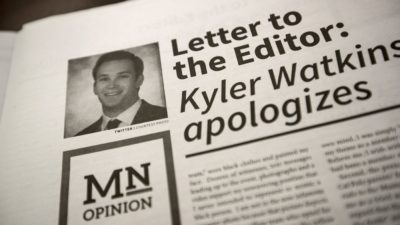Viet Thanh Nguyen reflects on the blackface incidents at Cal Poly in this piece originally published by the Los Angeles Times.

For the second time in a matter of weeks, a white student at Cal Poly San Luis Obispo wore blackface. After the first incident, in late April, the student who had worn blackface then, Kyler Watkins, wrote in a letter to the Cal Poly student newspaper that “growing up white and privileged, I was truly unaware of how insensitive I was to the racial implications of blackface.”
At first, I was angered and saddened. Then I thought about myself when I was around their age.
I was a political activist as a UC Berkeley undergraduate in the early 1990s. A believer in racial solidarity, I would never have worn blackface, or donned a sombrero for Cinco de Mayo, or dressed up as a Mexican gardener for Halloween. When I became co-chair of Berkeley’s Asian American Political Alliance, I was undoubtedly full of my supposedly radical self. I was shocked, then, when my fellow co-chair — a woman — and every other woman in the organization decided to stage a protest against me and every other man in AAPA for our sexist behavior.
They demanded that we be silent and listen to their allegations against us: taking credit for their work, speaking over them and being unaware of gender and the difference it made in almost everything. They demanded our recognition that the Asian American movement for justice would be hypocritical if it did not also demand justice for Asian American women.
These Asian American feminists did me a favor in confronting me. They did not make me a feminist with one protest, but they altered my view of myself. They gave me a glimpse of how deeply patriarchy and misogyny were ingrained in me. I have never forgotten that lesson, and grappling with the traces of patriarchy and misogyny within me remains an ongoing project.
My time at Berkeley taught me that both education and self-criticism matters when it comes to confronting the things we take to be natural. Sexism feels natural for many men, and even for some women, too. Racism feels natural as well, and not just for white people.
Growing up among Vietnamese people, I heard racism expressed against African Americans and Mexican Americans. The Vietnamese were doing what feels natural to so many immigrants — becoming American by becoming racist. Even if the Vietnamese might never become white, they could very definitely be not black.
These Vietnamese Americans would probably deny their racism and agree with Watkins when he wrote that his action “had nothing whatsoever to do with racism or discrimination.” But wearing blackface has everything to do with racism and discrimination, even if the student does not believe himself to be racist. Although I did not believe myself to be sexist as a college student, the effects of my actions were sexist.
More than this, perhaps I did intend to be sexist without even acknowledging it to myself. People with good intentions are often complicit with systems of power that benefit them, including systems of white privilege, male privilege and class privilege. Abusing others feels natural, because in the sexist or racist or classist imagination, the object of the abuse deserves it.
I was fortunate to attend a university where the undergraduate body was reasonably diverse, and where my fellow students let me know that my behavior was unacceptable. At a university like Cal Poly San Luis Obispo, the least racially diverse California State University campus, the population is 54.8% white. Black students comprise only 0.7% of the student body. Mr. Watkins was deprived — or deprived himself — of contact with African American students who might have taught him how offensive blackface is.
One function of education is to teach us what our worst instincts are and prevent us from following them. Cal Poly has not done its work to keep white students from acting on their privilege and students of color from feeling unwelcome and misunderstood. And Cal Poly is hardly unique.
Universities and other institutions need to replace good intentions with proactive solutions. Recruit a more diverse student body and faculty. Fund support services and build mentorship networks for students of color, first-generation immigrants, working-class students and every other population that needs this help. And do what a university is supposed to do: Educate.
These two Cal Poly students most likely would not have worn blackface had they studied slavery or lynching or segregation. Studying racism and the experiences of people of color in this country should be required in all high schools and universities. I would not be writing these words had I not been an ethnic studies major and the recipient of an affirmative-action fellowship when I went to graduate school.
But schools shouldn’t stop at issues of race. They should also educate their students about gender and sexuality. For all my racial consciousness, my feminist education began informally, through the intervention of Asian American feminists. They understood that when education failed, the students have to become the teachers.


